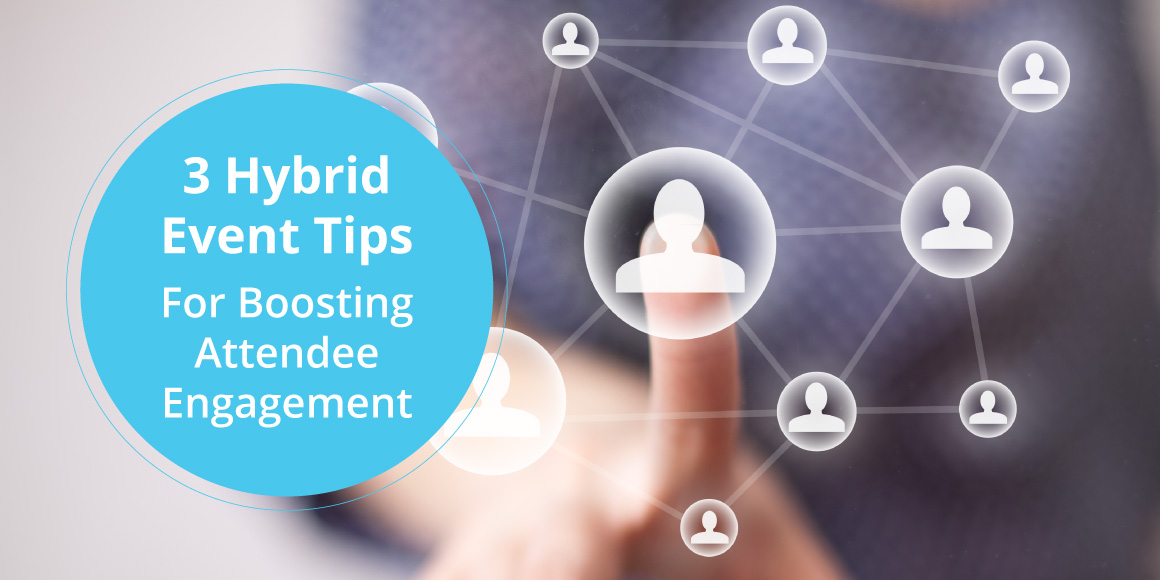Events are exciting occasions for your organization’s members to gather and build a community through shared interests and goals. But as your organization grows, it can become harder to include and engage all of your participants. As you drive more registrations, it’s important to make participating in the event accessible to as many members as possible.
Hybrid events are a great way to ensure any interested member can attend your event, no matter where they are. This approach aims to combine the benefits of virtual events’ higher attendance and flexible participation with the stronger personal networking opportunities of in-person events, creating a savvy, integrated event strategy.
The hybrid format also allows you to pass the benefits of high levels of member engagement to more attendees. As Fonteva’s guide to member engagement states, taking steps to improve engagement can increase member retention, build a strong community, and even increase non-dues revenue.
While these benefits make planning a hybrid event well worth your organization’s time, engaging both virtual and in-person participants equally is a hurdle that still poses a major problem. For example, some members may have limited exposure to technology and be confused by your online materials. Others may become disengaged without person-to-person interaction.
To avoid these common hybrid event pitfalls and increase multi-platform member engagement, we’ll explore these three essential tactics:
- Share event resources before the big day.
- Use gamification elements during the event.
- Offer community-building opportunities.
Perhaps you’re new to this kind of event development, or maybe you’ve already launched your own hybrid fundraisers, meet-ups, or auctions. Regardless of what level of familiarity you have with the hybrid model, these resources will help you bridge the gap to a new era of integrated event programming. Let’s get started!
1. Share event resources before the big day.
There are two key reasons your association should share about its event before the day it occurs. First, it can help attendees who are apprehensive about using technology get comfortable and familiar with the technology prior to the event.
For members who have never participated in a virtual event, they might have quite a few questions such as, “Is there any technology we have to download?” or “How can we engage and connect with other attendees?” To limit technical roadblocks, consider sending a few of the following helpful resources:
- Documentation on how to install necessary tools and software. With so many different kinds of competing video conferencing tools and online engagement platforms, try not to assume all members are prepared to install your preferred service without guidance. To create a seamless attendee experience, you should look for video conferencing software that integrates with your association management software.
- An FAQ list. Refer members to this list of frequently answered questions to save your staff members time. For more unique questions or troubleshooting, include contact information for designated staff members.
- Video tutorials and demos. Create or link to videos that walk through the steps your participants will need to take to use the technology required to attend the event. With these materials, your event registrants can watch to get familiar with the virtual event platform in advance.
- Pre-event presentations and Q&As. Create a presentation that walks through all the essential steps to preparing for and participating in the event. Make sure to leave ample time for questions.
The second reason to share about the event in advance is to generate buzz and excitement leading up to the big day.
When marketing your event, reaching your target audience through the channels they engage with the most is key. For some, this may be through email, while for others it could be social media. Promote the most exciting elements of the event, like having an industry celebrity as your keynote speaker. Remember to include convenient links to your registration page with each message. Interested individuals will then be able to get more information on your event.
2. Use gamification elements.
A common challenge for organizations that are transitioning to hybrid events is ensuring that everyone stays engaged. This is particularly difficult for virtual participants. To combat screen fatigue for your online attendees, consider incorporating gamification elements into your event.
Gamification involves applying gaming mechanics and reward systems to non-game systems, operations, and activities. The goal is to create a similar level of engagement and stimulation for users in a non-gaming environment that they might experience while playing an actual game.
Here are some popular gamification tactics you could implement for your virtual gatherings:
- Digital badges. This might include rankings like “Most engaged attendee!” or “Most thoughtful inquirer.” Recognizing user accomplishments will motivate participants to actively engage to earn new badges for their profiles.
- Points-to-rewards program. This uses positive reinforcement to encourage actions like registering early or attending an optional breakout session. With enough points, attendees can redeem their engagement for a physical reward, like a gift card or merchandise.
- Divide your attendees into teams and compete. This could mean putting on small contests, like a virtual trivia session, to encourage a bit of friendly competition. These mini-games can even be helpful to break the ice before lengthy online conferences or presentations.
If this sounds like it might be a lot to handle on top of all the other logistical details of a live event, look into technology that could help. Your AMS platform can track data that you can then use to gamify the event. For example, you can use built-in reporting features to identify all members who registered for the event early.
3. Offer community-building opportunities.
One of the biggest challenges at play when planning an engaging hybrid event or meeting is that your attendees experience the event in different ways. How can they connect when they’re physically separated from one another?
The solution is to think of ways that you can create intentional opportunities for members to talk and engage with each other in group or one-on-one settings. Consider the following member-to-member engagement techniques:
- Form breakout groups. Tackle engagement on a more manageable level by separating participants into smaller groups. This will facilitate more conversations and make it easier for individual members to connect.
- Unlock chat functionality and direct messaging. Opening up these functions allows each audience member to participate in their own meaningful way, no matter how (or from where) they’re joining.
- Wrap up Q&A. Make sure to provide time at the end of the event so that both in-person and virtual attendees have an opportunity to address concerns and let their voices be heard. To prep your speakers to field both in-person and virtual questions, consider giving them a session with a conference speaker coach.
Person-to-person member encounters are the key to creating more intimate experiences that can be missing for virtual attendees. By creating smaller groups and low-stakes ways to participate, your organization will open up unique channels of communication and maximize the presence of your attendees. Your virtual engagements will feel just as deep and genuine as if they had taken place in the same room.
It’s clear that hybrid events are the best way to gain the benefits of both in-person and virtual events. But to take full advantage of these benefits, you’ll need to pursue unique opportunities for engagement beyond what’s possible at an in-person event. As OneCauses’ guide to hosting a hybrid event says, capturing attendees’ attention is the key to a successful event—and to do so, you’ll need to leverage virtual event strategies that make your organization stand out.
By remaining attentive to your participants’ technological needs, taking advantage of game and reward strategies, and fostering a sense of community between members, you’ll confidently engage your event attendees with hybrid programming.




